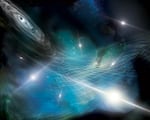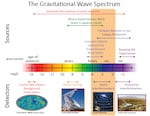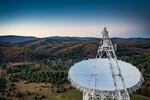
This composite released by NANOGrav show an artist’s interpretation of an array of pulsars being affected by gravitational ripples produced by a supermassive black hole binary in a distant galaxy.
Courtesy of Aurore Simonnet for the NANOGrav Collaboration
A breakthrough identification of distant signals in space is shedding new light on gravitational waves — one of science’s biggest mysteries.
Gravitational waves are like super-subtle ripples of gravitational energy moving through (the fabric of) space — a little like waves after you drop a pebble in the water. Except the pebble would be a supernova or colliding black hole and those waves could pass milliseconds to decades apart, or even longer. Detecting and understanding gravitational waves would advance our understanding of how galaxies have evolved and, even broader, provide a means of studying the universe essentially back to the moment after the Big Bang.
The waves were predicted by Albert Einstein’s theory of general relativity, but scientists didn’t detect one until a century later in 2015 at the Laser Interferometer Gravitational Wave Observatory (LIGO) facilities in southeast Washington and Louisiana. The waves came from the merging of two black holes about 30 times the mass of our sun and lasted just .2 seconds.

This graphic from NASA shows the relative speeds of gravitational waves from different sources and the tools we currently have or soon will have to detect them.
Courtesy of NASA/WMAP Science Team
Now, an international research team including researchers at Oregon State University and the University of Washington Bothell, have detected compelling evidence of much more faint gravitational wave signals with periods (the time it takes for a full wave cycle) of years to decades. They believe the signals come from merging black holes — called “supermassive black holes” — billions of times more massive than our sun.
At this point, no earthbound detection system (like LIGO) could realistically detect waves this slow. So the researchers harnessed 68 quickly-spinning pulsars (dead stars that emit highly regular pulses of energy) scattered around the Milky Way — essentially creating a gravitational wave detector spanning a huge section of space light years across.

This graphic released by NANOGrav shows approximate positions in our galaxy of pulsars included in NANOGrav’s 15-year data set. Pulsars are indicated by blue stars, while the position of the Earth is the yellow star.
Courtesy of NANOGrav
Gravitational waves stretch and compress space as they pass. By timing the subtle differences in the time it takes for the pulses of radiation from these pulsars to reach Earth, the scientists were able to see what appear to be gravitational waves.
“The large number of pulsars used in the … analysis has enabled us to see what we think are the first signs of the correlation pattern predicted by general relativity,” says Xavier Siemens of Oregon State University in a statement. Siemens is co-director of the North American Nanohertz Observatory for Gravitational Waves Physics Frontiers Center, the group that made the discovery.
Research groups in other parts of the world using similar techniques also announced evidence of gravitational waves this week. The groups are planning to combine their data in the coming months to add certainty to their findings.
Read the findings in a series of papers published in The Astrophysical Journal Letters here, here, here (lead author OSU’s Jeffrey Hazboun) and here. The researchers will also hold a live briefing about their discovery on Thursday at 10 a.m.

In this image released by NANOGrav, the radio frequency receiver platform for West Virginia's Green Bank Telescope rises above the dish.
Courtesy of Jay Young for Green Bank Observatory
